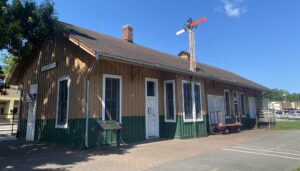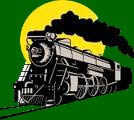The Northern Virginia Model Railroaders was founded in 1949. Our membership has grown from the original six founders to over ninety members today. Our members come from diverse professional and work backgrounds including a number of foreign countries; but, all share an enthusiasm for the hobby of model railroading. The club has had three locations in its sixty year existence: the first was in a member’s garage (only lasted one winter!); the second was the yardmaster’s office located in the Southern Railway Potomac Yard in Alexandria, Virginia; and for the last 30+ years it has been in the nineteenth century Washington and Old Dominion (W&OD) railroad depot in the historic center of Vienna, Virginia on Dominion Drive and Ayr Hill Avenue.

The Club Today
The club has been truly fortunate to have both the Northern Virginia Regional Park Authority and the Town of Vienna provide the depot for our use. At least ten times a year at our free open houses, members of the public are able to experience the layout in operation and also see the other historical railroad memorabilia on display. Once each month, the club also holds a formal operating session for the members using car cards and a fast clock.
Our layout is a HO Scale depiction of the Western North Carolina (WNC) Railroad from the towns of Spencer and Salisbury running west to Asheville over Black Mountain. This picturesque line passes through several small towns and villages, many of which are also present on our layout. The route also includes the fearsome mountain climb from Old Fort to Ridgecrest, a challenge for the real trains as well as those on the layout. The WNC has an interchange on the route with the Clinchfield Railroad, and this is also represented on our layout. Our visitors can see all the action from the viewing aisle as the trains steadily gain altitude negotiating the multiple levels before reaching Asheville. In the forefront of our railroad, there is the Blue Ridge Traction, Power & Light trolley system connecting with the railroad at two different passenger stations as well as Spencer Yard.
The layout is located in the 20 by 60 foot W&OD baggage room while the waiting room and ticket office contain models and artifacts for the public to view. Our layout design has stayed remarkably intact but has been continuously upgraded to incorporate the latest products including a Digitrax DCC control system, better scenery products and detailed structures. Many of the locomotives on the layout can reproduce the sounds of their prototype. Members continue to upgrade behind-the-scenes equipment, such as the extensive rewiring and electronics to improve operations, while others have made thousands of individual trees to give the genuine flavor of being in the Great Smoky Mountains.
The club owns a variety of Western North Carolina Railroad and Southern Railway locomotives and rolling stock. However, on any given Open House, you may see many other prototypes running since the Northern Virginia area draws from a large group of model railroaders who bring their own special interests with them.
NVMR’s Club House: The Vienna Depot of the Washington and Old Dominion Railroad

Built in 1859 by the Alexandria, Loudoun & Hampshire Railroad—predecessor of the Washington & Old Dominion Railway—the Vienna Depot served the Town of Vienna for 109 years until 1968 when the W&OD ceased operations. The railroad’s right-of-way is now the Northern Virginia Regional Park Authority’s (NVRPA) Washington & Old Dominion Railroad Regional Park. Known as the “W&OD Trail,” the park provides miles of paved trail for walking, running, bicycling and skating, as well as gravel trails for horseback riding. Our club has occupied the structure since August 15, 1977 and we have always taken great care to protect and preserve the unique features and historic character of the Vienna Depot.
Waiting Room:
We use the station’s waiting room for meetings, guest lectures and as a display area for railroadiana, including the Depot’s original Vienna signs and an HO-scale replica of the structure in its heyday. This model was built to demonstrate the club’s quality of modeling.

Station Agent’s Office:
The agent’s desk can still be seen in the Depot’s bay window. From here the agent could monitor passing trains, set the Depot’s train order semaphore signal, and advise other stations up and down the line of train movements. Against the right wall is our club’s dispatcher panel. We use this position during operating sessions to note and control the movement of trains on our HO-scale railroad.
Train Room: During the fall of 1977, we set about making this space suitable for both our model railroad and our visitors. This 50 by 22-ft. space had been the depot’s freight and motor generator rooms. Interior walls were unfinished.

Floors varied in quality, strength and height. The space had no ceilings, insulation, electrical service, heating or cooling systems.

We retained an architect, prepared working drawings, and received the required approvals of our plans. We then removed a partitioning wall and broke up weak sections of concrete floor. Working with the Town’s Department of Public Works, a new floor was poured. To finish the space while also protecting the building’s original structure, our members framed and insulated new walls within the room.
Overhead, we placed insulation and dropped a new ceiling. We brought in electrical service and installed new wiring and lighting, installed new heating and cooling systems, then finished and painted the new interior walls.

With the room complete, we turned to building our model railroad.

All track visible from the visitor’s aisle has been hand laid. An estimated 250,000 individual ties and spikes were consumed in this effort. Rail code heights vary depending on whether track is used as mainline, yard or for industrial sidings. For realism, rail was weathered and track ballasted according to southern practices.


Every great railroad must have a spiking ceremony. Ours was on February 11, 1978 when Vienna’s mayor, members of the Town Council, the Northern Virginia Regional Park Authority, and other dignitaries drove a Silver Spike commemorating completion of our mainline. More than 1,200 citizens visited our initial open house to see the first train traverse our model of the Western North Carolina Railroad.


